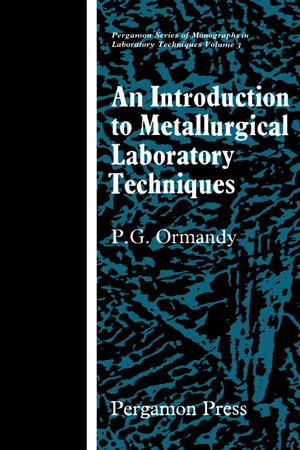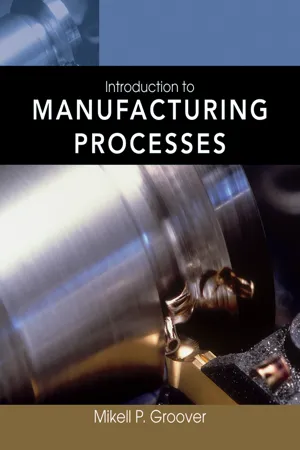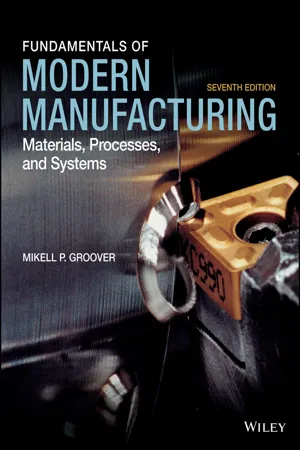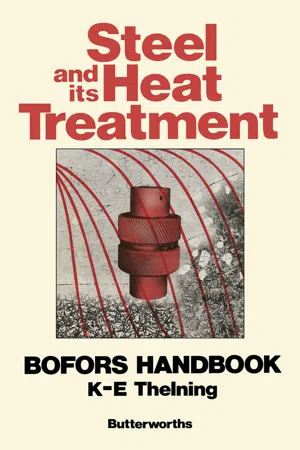Technology & Engineering
Annealing
Annealing is a heat treatment process used to alter the properties of materials such as metals and glass. By heating the material to a specific temperature and then slowly cooling it, annealing can relieve internal stresses, increase ductility, and improve the material's machinability. This process helps to refine the microstructure of the material, making it more uniform and stable.
Written by Perlego with AI-assistance
Related key terms
1 of 5
10 Key excerpts on "Annealing"
- eBook - PDF
- Bernhard Wunderlich(Author)
- 2012(Publication Date)
- Academic Press(Publisher)
7.1.1 Definitions and Processes of Annealing 349 certain property by heat treatment without large-scale melting. In a broader sense other treatments, such as chemical reaction and mechanical deforma-tion, can also achieve Annealing. An extensive knowledge has been collected during the last 100 years about the Annealing of metals, and in particualr steel. Macroscopically Annealing has metallurgically the object to impart ductility, extensibility, and a certain grade of softness. The opposite properties are achieved by hardening. Hardening in the shop sense signifies, for example, the making of a piece of steel as hard as possible. Intermediate stages between the hardened and an-nealed state are reached by tempering. Microscopically Annealing, harden-ing, and tempering can involve changing of crystal perfection, grain sizes and structure, chemical composition, and state of stress. In analogy to the metallurgical terminology, Annealing is used in poly-mer science to describe the improvement of crystallization by heating to temperatures below the melting point which should lead to the growing of crystalline areas, perfection of crystals, and a change to more stable crystal structures (Stuart, 1955).f In the plastics industry, Annealing is used to improve the heat resistance and dimensional stability of amorphous and crystalline polymers when ex-posed to elevated temperatures. Furthermore, Annealing frequently improves the impact strength and prevents crazing and cracking of excessively stressed items. Amorphous, rigid polymers are mainly annealed for stress relief, while crystalline polymers show, in addition, changes in the nature of their crystal-line state (Jastrzebski, 1965). Heat treatment of separate grains (powder) of a material may lead to agglomeration and compaction to a dense body, a process which is called sintering. - eBook - PDF
An Introduction to Metallurgical Laboratory Techniques
Pergamon Series of Monographs in Laboratory Techniques
- P. G. Ormandy, K. Guy(Authors)
- 2016(Publication Date)
- Pergamon(Publisher)
77 Metallurgical Laboratory Techniques Annealing In an earlier chapter in this book we mentioned the ability of a metal to harden by deformation processes. Normally this is beneficial to the mechanical properties of the metal, but if carried too far, it may lead to embrittlement by excessive strain-ing of the internal lattice. Annealing affords the simple means whereby the internal conditions of the metal is restored to its original state, without altering the actual physical degree of de-formation. Thus Annealing is extremely valuable if we desire to roll a piece of metal down to very thin strip in, say, fifty passes in a rolling mill. The metal might tend to crack from excessive work-hardening after ten passes; but if, after eight passes we anneal it, then a further eight passes may be carried out without any fear of failure, to be followed by another anneal, a further eight passes, and so on down to the requisite final deformation. Alternatively, Annealing is frequently used to remove harmful residual stresses in metals which might otherwise render them unreliable in service. Basically Annealing consists of heating a metal above a certain temperature, known as the recrystallization temperature. It is allowed to soak at this temperature for a predetermined time in order to allow the atoms to regain their equilibrium positions in the lattice, and then cooled at a predetermined rate to room temperature. Recrystallization temperatures of some common metals and alloys are given in Table 9. The process of Annealing ensures adequate grain growth, especially in metals that have been deformed plastically. Also grain growth causes a softening of the metal, thus allowing the metal to be worked further. Metals that have been cold-worked should be annealed to remove harm-ful stresses, but it is important to remember that working pro-motes grain growth, which may be beneficial. - eBook - PDF
- Mikell P. Groover(Author)
- 2012(Publication Date)
- Wiley(Publisher)
Heat treatment can also be accom- plished at or near the end of the sequence to achieve the final strength and hardness required in the finished product. The principal heat treatments are Annealing, martensite formation in steel, precipitation hardening, and surface hardening. 20.1 Annealing Annealing consists of heating the metal to a suitable temperature, holding at that temperature for a certain time (called soaking), and slowly cooling. It is performed on a metal for any of the following reasons: (1) to reduce hardness and brittleness, (2) to alter microstructure so that desirable mechanical properties can be obtained, (3) to soften metals for improved machinability or formability, (4) to recrystallize cold-worked (strain-hardened) metals, and (5) to relieve residual stresses induced by prior processes. Different terms are used in Annealing, depending on the details of the process and the temperature used relative to the recrystallization temperature of the metal being treated. Full Annealing is associated with ferrous metals (usually low and medium carbon steels); it involves heating the alloy into the austenite region, followed by slow cooling in the furnace to produce coarse pearlite. Normalizing involves similar heating and soaking cycles, but the cooling rates are faster. The steel is allowed to cool in air to room temperature. This results in fine pearlite, higher strength and hardness, but lower ductility than the full anneal treatment. Cold-worked parts are often annealed to reduce effects of strain hardening and increase ductility. The treatment allows the strain-hardened metal to recrystallize partially or completely, depending on temperatures, soaking periods, and cooling rates. When Annealing is performed to allow for further cold working of the part, it is called a process anneal. - eBook - PDF
Fundamentals of Modern Manufacturing
Materials, Processes, and Systems
- Mikell P. Groover(Author)
- 2019(Publication Date)
- Wiley(Publisher)
592 P A R T VII 26 PROPERTY ENHANCING AND SURFACE PROCESSING OPERATIONS The manufacturing processes in the preceding chapters involve the creation of workpiece geometry. This part of the book covers processes that either enhance the properties of a work part (this chapter) or apply some surface treatment to it, such as clean- ing or coating (Chapter 27). Property-enhancing operations are performed to improve mechanical or physical properties of the work material. They do not alter part geometry, at least not inten- tionally. The most important property-enhancing operations are heat treatments. Heat treatment consists of various heating and cooling procedures performed to effect microstructural changes in a material, which in turn affect its mechanical properties. Its most common applications are on metals, discussed in this chapter. Similar treatments are performed on glass-ceramics (Section 7.4.3), tempered glass (Section 12.3.1), and powder metals and ceramics (Sections 15.3.3 and 16.2.3). Heat treatment operations can be performed on a metallic work part at various times during its manufacturing sequence. In some cases, the treatment is applied before shaping (e.g., to soften the metal so that it can be more easily formed while hot). In other cases, heat treatment is used to relieve the effects of strain hardening that occur during forming, so that the material can be sub- jected to further deformation. Heat treatment can also be accomplished at or near the end of the sequence to achieve the final strength and hardness required in the finished product. The principal heat treatments are Annealing, martensite formation in steel, precipitation hardening, and surface hardening. 26.1 Annealing Annealing consists of heating the metal to a suitable temperature, holding at that temperature for a certain time (called soaking), and slowly cooling. - J. T. Black, Ronald A. Kohser(Authors)
- 2019(Publication Date)
- Wiley(Publisher)
CHAPTER 5 67 5.1 Introduction In the previous chapters, you were introduced to the interre- lationships among the structure, properties, processing, and performance of engineering materials. Chapters 3 and 4 consid- ered the aspects of structure, whereas Chapter 2 focused on the properties. In this chapter, we begin to incorporate processing as a means of manipulating and controlling the structure and the companion properties of materials. Many engineering materials can be characterized not by a single set of properties but by an entire spectrum of possibili- ties that can be selected and varied at will. Heat treatment is the term used to describe the controlled heating and cooling of materials for the purpose of altering their structures and proper- ties. The same material can be made weak and ductile for ease in manufacture and then retreated to provide high strength and good fracture resistance for use and application. Because both physical and mechanical properties (such as strength, tough- ness, machinability, wear resistance, and corrosion resistance) can be altered by heat treatment, and these changes can be induced with no concurrent change in product shape, heat treat- ment is one of the most important and widely used manufactur- ing processes. Technically, the term heat treatment applies only to the processes in which the heating and cooling are performed for the specific purpose of altering properties, but heating and cooling often occur as incidental phases of other manufactur- ing processes, such as hot forming or welding. The structure and properties of the material will be altered, however, just as though an intentional heat treatment had been performed, and the results can be either beneficial or harmful. For this rea- son, both the individual who selects material and the person who specifies its processing must be fully aware of the possible changes that can occur during heating or cooling activities.- eBook - PDF
Treatise on Materials Science and Technology
Ultrarapid Quenching of Liquid Alloys
- Herbert Herman(Author)
- 2012(Publication Date)
- Academic Press(Publisher)
TREATISE ON MATERIALS SCIENCE AND TECHNOLOGY, VOL. 20 6 Annealing Effects in Metallic Glasses^ MARIA LASOCKA and HENRYK MATYJA Institute of Materials Science and Engineering Warsaw Technical University Warsaw, Poland I. Introduction 261 II. Thermodynamic Aspects of Annealing 262 A. Transformation Region 262 B. Internal Parameters 263 C. Analogy between Glass Transition and Melting 265 D. Stabilization 266 E. Relaxation Phenomena 267 F. Typical Experiments in Relaxation Studies 271 III. Basic Effects of Annealing in Metallic Glasses 274 A. Experimental Evidence of Structural Relaxation 275 B. General Trends of Property Changes during Annealing 277 IV. Closing Remarks 286 References 286 I. Introduction The properties of glasses can be changed by a variety of thermal and mechanical treatments. Direct structural evidence is difficult to obtain and current views are based on a variety of sometimes contradictory results. Since the glassy state is metastable, even below T g —in the region of high viscosity—structural relaxation occurs in order to approach a lower energy state. The glassy state is generally not well defined thermodynamically, but under particular circumstances pseudoequilibrium conditions can be as-sumed and thermodynamic arguments employed. In general, the proper-ties of glasses may be considered to be a function of the excess enthalpy t Financial support by N S F Grant N o . INT73-02279 A02 is greatly appreciated. 261 Copyright © 1981 by Academic Press, Inc. All rights of reproduction in any form reserved. ISBN-0-12-341820-8 262 MARIA LASOCKA A N D H E N R Y K MATYJA during isothermal Annealing over the temperature range below their re-spective glass transition temperatures. The changes in properties are as-sumed to be parallel to the extent of enthalpy relaxation that occurs during the Annealing period as a result of the nonequilibrium state of the glassy phase. - eBook - PDF
Steel and Its Heat Treatment
Bofors Handbook
- Karl-Erik Thelning(Author)
- 2013(Publication Date)
- Butterworth-Heinemann(Publisher)
5 Heat treatment—general The preceding chapters have dealt with the theoretical background of the heat treatment of steel. The following chapters are based mainly on practical experience and applications. This general section describes the standard heat-treatment techniques on which are based the special methods described in the next chapter. 5.1 A N N E A L I N G The general purpose of an Annealing treatment is to reduce the hardness of steel or to produce a structure that facilitates the progress of subsequent manufacturing operations. The term Annealing by itself usually implies full Annealing, which in most cases involves solution treatment in the austenite phase followed by slow cooling. For other types of Annealing prefixes that indicate the nature of the process are generally used. 5.1.1 Annealing for maximum softness or Spheroidizing Anneal The theory of this apparently simple heat-treatment operation is still rather obscure but on the basis of practical experience and on data derived from isothermal (TTT) and continuous cooling (CCT) transformation diagrams, almost ideal Annealing practices have been developed. The classic spheroidiz-ing Annealing temperatures for carbon steels are shown in Figure 5.1, where it can be seen that for hypo-eutectoid steels Annealing below A± is suggested. However, Annealing above A x followed by transformation just below A l is to be recommended in many instances as outlined below. When a steel with a pearlite structure is annealed the cementite lamellae after a short time assume the fanciful shape of a dog's leg. On continuing the Annealing the lamellae form globules at their ends and split up into spheroids; hence the name spheroidizing. As the temperature is increased the process speeds up. Figure 5.2 is typical of the fully spheroidized structure of a tool steel. If the Annealing treatment is carried out below A 1 the rate of cooling does not influence the final hardness at room temperature. If 177 - eBook - PDF
Fundamentals of Materials Science and Engineering
An Integrated Approach
- William D. Callister, Jr., David G. Rethwisch(Authors)
- 2022(Publication Date)
- Wiley(Publisher)
An Annealing heat treatment called normalizing is used to refine the grains (i.e., to decrease the average grain size) and produce a more uniform and desirable size distribution; fine-grained pearlitic steels are tougher than coarse-grained ones. Normalizing is accomplished by heating at least 55°C above the upper critical temperature—that is, above A 3 for compositions less than the eutectoid (0.76 wt% C), and above A cm for compositions greater than the eutectoid, as represented in Figure 15.7. After sufficient time has been allowed for the alloy to completely transform to austenite—a procedure termed austenitizing—the treatment is terminated by cooling in air. A normalizing cooling curve is superimposed on the continuous-cooling transformation diagram (Figure 12.27). Full Anneal A heat treatment known as full Annealing is often used in low- and medium-carbon steels that will be machined or will experience extensive plastic deformation during a forming operation. In general, the alloy is treated by heating to a temperature of about 50°C above the A 3 line (to form austenite) for compositions less than the eutectoid, or, for compositions in excess of the eutectoid, 50°C above the A 1 line (to form austenite and Fe 3 C phases), as noted in Figure 15.7. The alloy is then furnace cooled—that is, the heat-treating furnace is turned off, and both furnace and steel cool to room tem- perature at the same rate, which takes several hours. The microstructural product of this anneal is coarse pearlite (in addition to any proeutectoid phase) that is relatively soft and ductile. The full-anneal cooling procedure (also shown in Figure 12.27) is time consuming; however, a microstructure having small grains and a uniform grain structure results. - eBook - PDF
- William F. Hosford(Author)
- 2010(Publication Date)
- CRC Press(Publisher)
115 9 Annealing 9.1 GENERAL Annealing is heating of metal after it has been cold worked to soften it. Most of the energy expended in cold work is released as heat during the deformation. However, a small percent is stored by dislocations and vacancies (Figure 9.1). The stored energy is the driving force for the changes during Annealing. There are three stages of Annealing. In order of increasing time and temperature, they are 1. Recovery—often a small drop in hardness, rearrangement of dislocations to form subgrains. Otherwise overall grain shape and orientation remain unchanged. 2. Recrystallization—replacement of cold-worked grains by new ones. There are new orientations, a new grain size, and a new grain shape (but not nec-essarily equiaxed). Recrystallization causes the major hardness decrease. 3. Grain growth—growth of recrystallized grains at the expense of other recrystallized grains. 9.2 RECOVERY The energy release during recovery is largely due to Annealing out of point defects and rearrangement of dislocations. Most of the increase of electrical resistivity dur-ing cold work is attributable to vacancies. These anneal out during recovery, so the electrical resistivity drops (Figure 9.2) before any major hardness changes occur. During recovery, residual stresses are relieved and this decreases the energy stored as elastic strains. The changes during recovery cause no changes in microstruc-ture that would be observable under a light microscope. Figure 9.3 shows the energy release and the changes of resistivity and hardness with increasing Annealing temperatures. There is also a rearrangement of dislocations into lower energy configurations such as low-angle tilt boundaries (Figure 8.10). In single crystals, these boundaries lead to a condition called polygonization , in which a bent crystal becomes facetted (Figure 9.4). In polycrystals, these low-angle boundaries form subgrains that differ in orienta-tion by only a degree or two. - eBook - PDF
- William F. Gale, Terry C. Totemeier(Authors)
- 2003(Publication Date)
- Butterworth-Heinemann(Publisher)
2 PROCESS (SUBCRITICAL) Annealing Process Annealing (Figure 29.14) is performed to improve the cold-working properties of low-carbon steels (up to 0.25% carbon) or to soften high-carbon and alloy steels to facilitate shearing, turning or straightening processes. 30,31 Process Annealing involves heating the steel to a temperature below (typically 10–20 ◦ C below) the lower critical temperature (Ac 1 ) and is often known as ‘subcritical’ Annealing. After heating, the steel is cooled to room temperature in still air. The process Annealing temperatures for plain carbon and low alloy steels is typically limited to about 700 ◦ C to prevent partial reaustenitisation. In some cases this is limited to about 680 ◦ C for steel compositions, such as high-nickel containing steels, where the nickel further reduces the Ac 1 temperature. 31 This process can be used to temper martensitic and bainitic microstructures to produce a soft-ened microstructure containing spheroidal carbides in ferrite. 31 Fine pearlite is also relatively easily softened by process Annealing, while coarse pearlite is too stable to be softened by this process. 1600 1500 1400 1300 1200 1100 1000 900 800 700 600 500 400 Temp. ( ° C) Stress relieving Process & recrystallisation Annealing Spheroidising Partial Annealing Normalising Diffusion Annealing Hot working & homogenisation Full Annealing 2.0 1.5 1.0 0.5 0 % C Figure 29.14 Annealing-related processes in plain carbon steels Heat treatment of steel 29 –27 RECRYSTALLISATION Annealing Prior to cold working, steel microstructures that are either spheroidised or ferritic are highly ductile. However, when steels are cold worked, they become work hardened and ductility is reduced. Work hardening resulting from cold working can be removed by a recrystallisation process which produces strain-free grains, resulting in a ductile, spheroidised microstructure.
Index pages curate the most relevant extracts from our library of academic textbooks. They’ve been created using an in-house natural language model (NLM), each adding context and meaning to key research topics.









